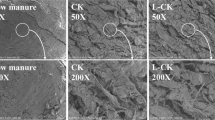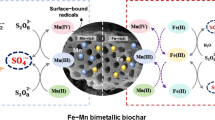Abstract
Batch bioleaching experiments were conducted using the Fe(III)-reducing bacteria, Shewanella putrefaciens CN32, to determine the effect of the Fe(III) reduction on As mobilization. For this purpose, Fe(III) reduction experiments were also performed to deduce the optimum conditions of the bioleaching experiment. In the Fe(III) reduction experiment, insoluble Fe(III), such as synthesized poorly and well crystalline hydrous ferric oxide (HFO), was rarely used as electron acceptor by S. putrefaciens. However, the addition of a humic substance (2,6-anthraquinone disulfonate, AQDS) greatly increased iron reduction capacity (5–10 times) under the same conditions. For the poorly and well crystalline HFO, the effective carbon sources as electron donor were acetate and lactate, respectively. In bioleaching experiments using the two types of synthesized Fe(III) oxide minerals bearing As (poorly crystalline HFO and well crystalline HFO), S. putrefaciens enhanced the As mobilization, with 1,870 and 1,460 mg kg−1 of As released in the poorly and well crystalline HFO, respectively. From a correlation coefficient analysis between reduced Fe and released As, the R 2 values were 0.8612 and 0.9115, respectively. These results indicated that the reduction of Fe(III) can enhance the As mobilization. Therefore, bioleaching using the Fe(III)-reducing mechanism can be useful for remediation of As contaminated soil.






Similar content being viewed by others
References
Nriagu JO (EDT) (1994) Arsenic in the Environment, human health and ecosystem effects. Wiley, London
Pierce ML, Moore CB (1982) Adsorption of arsenite and arsenate on amorphous iron hydroxide. Water Res 16(7):1247–1253
Masscheleyn PH, Delaune RD, Patrick WH Jr (1991) Effect of redox potential and pH on arsenic speciation and solubility in a contaminated soil. Environ Sci Technol 25(8):1414–1419
Tamaki S, Frankenberger WT (1992) Environmental biochemistry of arsenic. Rev Environ Contam Toxicol 124:79–110
Macur RE, Wheeler JT, McDermott TR, Inskeep WP (2001) Microbial populations associated with the reduction and enhanced mobilization of arsenic in mine tailings. Environ Sci Technol 35(18):3676–3682
Bowen HJH (1979) Environmental chemistry of the elements. Academic Press, New York
Lindau L (1977) Emissions of arsenic in Sweden and their reduction. Environ Health Persp 19:25–30
Nelson KW (1977) Industrial contributions of arsenic to the environment. Environ Health Persp 19:31–34
Alloway BJ (1995) Soil processes and the behavior of heavy metals. In: Alloway BJ (ed) Heavy metals in soils, 2nd edn. Blackie Academic and Professional Publishers, New York
Blais JF, Auclair JC, Tyagi RD (1992) Cooperation between two Thiobacillus strains for heavy metal removal from municipal sludge. Can J Microbiol 38(3):81–187
Ahonen L, Tuovinen OH (1995) Bacterial leaching of complex sulfide ore samples in bench-scale column reactors. Hydrometallury 37(1):1–21
Sadiq M (1997) Arsenic chemistry in soils: an overview of thermodynamic predictions and field observation. Water Air Soil Poll 93(1):117–136
Matera V, Le He′cho I, Laboudigue A, Thomas P, Tellier S, Astruc MA (2003) Methodological approach for the identification of arsenic bearing phases in polluted soils. Environ Pollut 126(1):51–64
Lovley DR, Phillips EJP (1988) Novel mode of microbial energy metabolism: organic carbon oxidation coupled to dissimilatory reduction of iron or manganese. Appl Environ Microbiol 54(6):1472–1480
Lovley DR, Giavannoni SJ, White DC, Champine JE, Phillips EJP, Gorby YA, Goodwin S (1993) Geobacter metallireducens gen. nov. sp. nov., a microorganism capable of coupling the complete oxidation of organic matter to the reduction of iron and other metals. Arch Microbiol 159(4):336–344
Semple KM, Westlake DWS (1987) Characterization of iron reducing Alteromonas putrefaciens strains from oilfield fluids. Can J Microbiol 33(5):366–371
Myers CR, Nealson KH (1988) Bacterial manganese reduction and growth with manganese oxide as the sole electron acceptor. Science 240(4875):1319–1321
Caccavo F Jr, Coates JD Jr, Rosselo-Mora RA, Ludwig W, Schleifer KH, Lovley DR, McInerney MJ (1996) Geovibrio ferrireducens, a phylogenetically distinct dissimilatory Fe(III)-reducing bacterium. Arch Microbiol 165(6):370–376
Laverman AM, Blum JS, Schaefer JK, Phillips EJP, Lovley DR, Oremland RS (1995) Growth of strain SES-3 with arsenate and other diverse electron acceptors. Appl Environ Microbiol 61(10):3556–3561
Lonergan DJ, Jenter HL, Coates JD, Phillips EJ, Schmidt TM, Lovley DR (1996) Phylogenetic analysis of dissimilatory Fe(III)-reducing bacteria. J Bacteriol 178(8):2402–2408
Liesack W, Finster K (1994) Phylogenetic analysis of five strains of gram-negative, obligately anaerobic, sulfur-reducing bacteria and description of Desulfuromusa gen. nov., including Desulfuromusa kysingII sp. nov., DesulfuromusabakII sp. nov., and Desulfuromusa succinoxidans sp. nov. Int J Syst Bacteriol 44(4):753–758
Roden EE, Lovley DR (1993) Dissimilatory Fe(III) reduction by the marine microorganism Desulfuromonas acetoxidans. Appl Environ Microbiol 59(3):734–742
Lovley DR (1991) Dissimilatory Fe(III) and Mn(IV) reduction. Microbiol Rev 55(2):259–287
Fredrickson JK, McKinley JP, Bjornstad BN, Ringelberg DB, White DC, Krumholz LR, Suflita JM, Colwell FS, Lehman RM, Phelps TJ (1997) Pore-size constraints on the activity and survival of subsurface bacteria in a late Cretaceous shale sandstone sequence, northwestern New Mexico. Geomicrobiol J 14(3):183–202
Sugimoto T, Sakata K, Muramatsu A (1993) Formation mechanism of monodisperse pseudocubic α-Fe2O3 particles from condensed ferric hydroxide gel. J Colloid Interf Sci 159(2):372–382
Stookey LL (1970) Ferrozine-A new spectrophotometric reagent for iron. Anal Chem 42(7):779–781
Wenzel WW, Kirchbaumer N, Prohaska T, Stingeder GE, Adriano DC (2001) Arsenic fractionation in soils using an improved sequential extraction procedure. Anal Chim Acta 436(2):309–323
Lovley DR, Coates JD, Blunt-Harris EL, Phillips EJP, Woodward JC (1996) Humic substances as electron acceptors for microbial respiration. Nature 382:445–448
Lovley DR, Fraga JL, Blunt-Harris EL, Hayes LA, Phillips EJP, Coates JD (1998) Humic substances as a mediator for microbially catalyzed metal reduction. Acta Hydroch Hydrob 26(3):152–157
Nealson KH, Belz A, McKee B (2002) Breathing metals as a way of life: geobiology in action. Anton Leeuw Int J G 81(2):215–222
Nevin KP, Lovley DR (2002) Mechanisms for accessing insoluble Fe(III) oxide during dissimilatory Fe(III) reduction by Geothrix fermentans. Appl Environ Microb 68(5):2294–2299
Hernandez ME, Newman DK (2001) Extracellular electron transfer. Cell Mol Life Sci 58(11):1562–1571
Fredrickson JK, Zachara JM, Kennedy DW, Dong H, Onstott TC, Hinman NW, Li SM (1998) Biogenic iron mineralization accompanying the dissimilatory reduction of hydrous ferric oxide by a groundwater bacterium. Geochim Cosmochim Acta 62(19/20):3239–3257
Roden EE, Zachara JM (1996) Microbial reduction of crystalline iron(III) oxides: influence of oxide surface area and potential for cell growth. Environ Sci Technol 30:1618–1628
Roden EE (2003) Fe(III) oxide reactivity toward biological versus chemical reduction. Environ Sci Technol 37:1319–1324
Zachara JM, Fredrickson JK, Li SW, Kennedy DW, Smith SC, Gassman PL (1998) Bacterial reduction of crystalline Fe(III) oxides in single phase suspensions and subsurface materials. Am Mineral 83:1426–1443
Author information
Authors and Affiliations
Corresponding author
Rights and permissions
About this article
Cite this article
Lee, SW. Enhancement of arsenic mobility by Fe(III)-reducing bacteria from iron oxide minerals. J Mater Cycles Waste Manag 15, 362–369 (2013). https://doi.org/10.1007/s10163-013-0132-y
Received:
Accepted:
Published:
Issue Date:
DOI: https://doi.org/10.1007/s10163-013-0132-y




